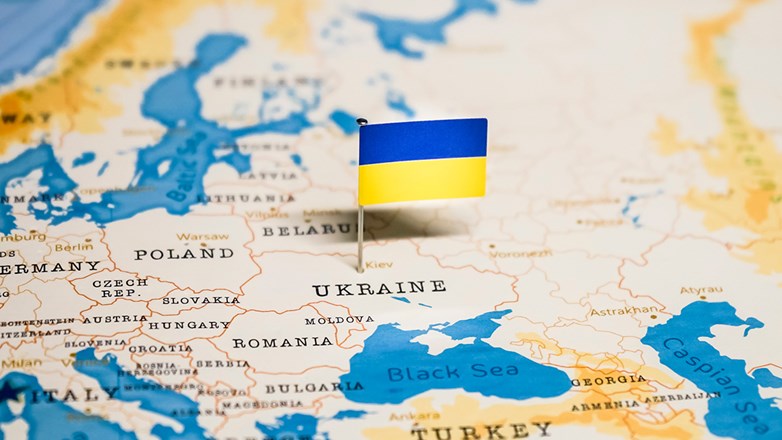Foreign aid to Ukraine: Lessons from the literature on strategic foreign aid
One of many consequences of the Russian war on Ukraine is that western countries have responded by providing substantial bilateral financial support to Ukraine. This support has taken the form of humanitarian, financial and military aid. As of August 3rd 2022, the US has provided the most support in absolute terms (44,5 billion euro), followed by EU institutions (16,2 billion euro) and the United Kingdom (6,5 billion euro). Relative to GDP, countries in Eastern Europe have however been the most generous, led by Estonia and Latvia (0,9 percent of GDP) and Poland (0,6 percent of GDP) (Antezza et al., 2022). Meanwhile, a discussion on the reconstruction of Ukraine has started, following the massive destruction of physical capital from the Russian aggression. The immense costs of this destruction increase every day, and the reconstruction effort for a future “Ukraine 2.0” will likely require thousands of billions of $US, mainly in the form of foreign aid (Becker at al., 2022).
Against this background, it is important to consider the academic and policy-oriented literature on aid effectiveness, i.e., to what extent aid impacts economic development and social welfare. Aid effectiveness involves many different dimensions such as issues of donor coordination, responsibility for reforms and investment choices of government and people (ownership), how to avoid corruption and so-called “white elephants” (expensive and useless investments), and how to effectively implement evaluation and evidence-based policy choices (e.g. OECD, 2008). In this brief, I will focus my attention on one such dimension, the underlying donor purpose of aid giving, and its implications for the contribution of aid inflows to human welfare in partner countries. More specifically I will discuss strategic aid, aid given primarily for the purpose of donor’s own broader foreign policy agendas. I will discuss what the literature has to say about the existence of such strategic aid, and what it has to say about its implications for aid flows and aid effectiveness. This will be done on basis of the existing literature, including a few of my own contributions. It is important to note that this literature focuses on development aid, defined by the OECD as “Official Development Assistance” (ODA). ODA does not include for instance military aid but is rather defined as official flows that explicitly target economic development and social welfare in the partner country. This literature is thus most relevant when talking about the reconstruction of Ukraine and to some extent the current financial and humanitarian aid given to the country.
Identifying the existence of strategic aid
In the quantitative literature, there are primarily two approaches to measuring the strategic incentives behind aid disbursements. The first approach looks at the distribution of foreign aid across partner countries with different levels of needs, institutional capacity to absorb aid inflows, commercial potential, historical ties to donors, and strategic importance. If aid was based only on altruistic motives we would expect aid allocation to strongly favour partner countries with low human development (measured by, e.g., GDP per capita levels, poverty headcount ratios and child mortality) and the capacity to turn aid inflows into social welfare (measured by e.g., indices of macroeconomic policies, democracy scores and corruption indicators). While the empirical literature suggests this is partly true, although more so for some donors than others, it is far from the whole picture. Many donors tend to favour former colonies or countries of commercial interest, observed by flows of trade and foreign direct investments (e.g., Neumayer, 2003; Berthelemy and Tichit, 2004). The same is true for strategic interests, although their importance varies substantially across donors (more so for the US and less for the Scandinavian countries, for instance). This is also true across a broad set of proxies for strategic relevance, all trying to capture foreign policy alliances or foreign policy importance, such as arms imports (Hess, 1989; Maizels, and Nissanke, 1984), arms expenditures (Schraeder et al., 1998), the correlation of voting records in the UN General Assembly (Alesina and Dollar, 2000), and dummies for Israel and Egypt (capturing the significance of the Israel-Palestine peace process).
In Frot, Olofsgård and Perrotta Berlin (2014), we take a closer look at the Central and Eastern Europe (CEEC) countries and the Commonwealth of Independent States (CIS) in the early years of their transition towards market economies. As these countries opened up a substantial amount of western aid became available, but the allocation of aid across countries varied substantially, as did needs, commercial potential and strategic significance to major donors. We argue that these motivations may have also played a different role at different times. In particular, there is a strategic advantage of early market access if aid flows are driven by commercial interests, suggesting that trade and investment relationships may play a more prominent role for aid allocation early on and less so as private partnerships have been [increasingly] established. Similarly, some strategic considerations were particularly salient early on, such as supporting nuclear disarmament and building a bulwark in Eastern Europe against the perceived remaining military threat of Russia. When disaggregating the data over time, we do indeed find that commercial interests played a much more prominent role in the first half of the 1990’s than in later years. Similarly, we find that countries with nuclear arms and countries located geographically closer to Brussels benefit particularly during these early years. As time went by, commercial interests became less important, needs variables gained more traction, and aid seems to rather have been used to reward countries undergoing deeper democratic reforms (Frot, Olofsgård and Perrotta Berlin, 2014).
The second approach is to focus on how aid flows are generally affected by changes to the strategic importance of a partner country, or partner countries, over time. In Boschini and Olofsgård (2007) we estimate the role of the intensity of the Cold War on aggregate levels of foreign aid from western donors. It is commonly argued that foreign aid was (partially) used as an instrument to gain political loyalty from leaders in the developing world during the Cold War and that the substantial drop in aggregate aid levels witnessed in the 1990’s can be explained by the disappearance of an important strategic motive behind foreign aid altogether (e.g. Lancaster, 2008). This had however not been tested in quantitative terms, and thus we collected data on military spending in the Eastern bloc to serve as a proxy for the intensity of the Cold War. We found that there was a positive correlation between military expenditures in the east and western development assistance during the period 1970-1990. After the Cold War, military expenditures in the east have no correlation with western development assistance. This suggests that development assistance was used as a complement to recipient’s domestic military spending in producing strategic security within donor countries. Once the Cold War ended though, the immediate need for such investments in security and loyalty abroad largely disappeared, ending the connection between military spending in the east and western development assistance and causing overall aid levels to drop. Kilby and Fleck (2010) find a similar but reverse effect of the war on terror following the 9/11 attack on the US in 2001. Overall aid flows increased, and the allocation across countries became biased in favour of countries of greater importance to the US in the War on Terror.
Another strand of literature has focused on what happens to aid inflows when a country becomes a temporary member of the UN Security Council (UNSC). This literature looks primarily at the impact on aid from multilateral aid agencies such as the World Bank and the International Monetary Fund (IMF). The rationale for the analysis is the notion that (western) permanent members on the UNSC have strategic interest in showcasing broad majority support for their resolutions at the council. This gives them an incentive to “buy support” from temporary members through influence over multilateral aid agencies.
Accordingly, Dreher et al. (2009a) find that partner countries receive a greater number of aid projects from the World Bank during years of UNSC membership than during the years before and after membership. Similarly, Dreher et al. (2009b) find that participation in IMF programs increases during membership years, and that agreements have fewer policy conditions.
In a recent paper (Berlin Perrotta, Desai and Olofsgård, 2022) we look at temporary UNSC membership and World Bank aid. Following the previous literature, we analyse whether temporary UNSC members receive more aid projects, but with a larger data set. Providing originality, we also test whether partner country governments are given more leeway to allocate aid projects regionally for political purposes during the years of UNSC membership. The argument is that donors can give partner country governments benefits not only in terms of the amount of aid, but also the extent to which they are free to spend resources based on political interests rather than needs. More specifically, we test whether birth region of political leaders, and regions dominated by co-ethnics of the political leader in question, receive a particular boost to aid inflows during membership years. We select these indicators of domestic political importance based on an existing literature which suggests governments at times favour such regions for public spending (e.g., Bommer et al., 2022; Briggs, 2014).
Consistent with earlier findings, we confirm that temporary members of the UNSC receive a greater number of World Bank projects during membership years than what they would otherwise receive. We also find partial support for the hypothesis that partner country governments have greater leeway to redirect projects to politically favoured regions. More specifically, co-ethnic regions get a boost in the number of projects and total aid inflows during membership years, whereas we find no similar impact in the leader’s home regions. More detailed analysis reveals that our results are driven by countries that persistently vote in line with the US in the committee, further supporting the interpretation that this reflects a trade of favours (Berlin Perrotta, Desai and Olofsgård, 2022).
The consequences of strategic aid
But does the underlying motive behind foreign aid matter? Development aid can of course benefit social and economic welfare in a partner country if invested in activities with positive social rates of return (e.g., schools, health care and infrastructure), irrespective of any underlying motivation. A strategic motivation can even be beneficial if it means that partner countries receive more aid than they would do in its absence. Consider the drop in total western aid budgets after the end of the Cold War, and the increase after the start of the War on Terror, as previously mentioned. Similarly, often referred to as the first example of foreign aid, the Marshall Plan to help rebuild Europe after the 2nd World War, was not only motivated by altruistic reasons. It was explicitly motivated by the need to maintain US national security and safeguard US access to European markets. Yet, the plan is hailed as a success, vital to the reconstruction of Europe after the war. It is also evident that popular support for aid to Ukraine in western donor countries partly depend on the conception of a threat to Europe and the free world, facilitating/enabling governments to be generous in their support.
There are however also examples of where strategic considerations have motivated aid with very limited or even negative impact on economic development and social welfare in partner countries. In particular during the Cold War, in order to gain loyalty in the ideological battle between the superpowers, western aid often went to highly corrupt regimes with low absorptive capacity (e.g., Easterly, 2006). A frequently mentioned example is the case of the Democratic Republic of Congo (DRC) during the regime of Mobutu Sese Seko. The US provided the country with more than a billion $US in development aid between 1962 and 1991, under a kleptocratic regime that impoverished the country (see here). This without doubt helped the regime stay in power, and the aid was thus not just a waste of resources but directly counterproductive.
Another argument at the global level is that there always exists an opportunity cost in the sense that strategic objectives reallocate limited aid resources from where the need is the greatest, to countries more politically salient. Burnside and Dollar (2000) run a simulation based on their empirical findings, changing the actual (partially donor interest based) allocation of aid across partner countries to an allocation based on need and absorptive capacity (which they associate with macroeconomic policies). Within their sample, they estimate such a reallocation to increase per capita growth by 0,2 to 0,3 percentage points, from a mean growth rate of 1,1 percent. Such calculations are of course rough estimates, yet they give a ballpark figure.
In the case of Ukraine however, the first of these arguments carry little weight. Aid is not sustaining a dysfunctional government with little interest in its own population, rather the opposite is true. On the other hand, the argument of allocative efficiency may carry some weight at a global scale. The needs and the human suffering in Ukraine are immense but unfortunately there are other places in the world with such extensive suffering (Ethiopia, Yemen, and Somalia to mention a few examples). There is thus concern within the donor community that the attention to Ukraine will negatively affect resources and attention to other places in need of support, in particular since the war has externalities in the form of increased food and energy prices in low-income countries. Such argument however relies on the assumption of crowding out resources from a budget of given size. While hard to prove, it is probably safe to say that the strategic interest in Ukraine has in fact increased the total budget available. As for now, it is therefore not entirely clear to what extent resources to other nations in need will be crowded out. Yet, the UN’s appeal for Ukraine is more than 80 percent funded for this year, whereas the UN’s response plan for Afghanistan is around 38 percent funded, Yemen’s is around 27 percent funded and Sudan’s is around 20 percent funded (see here).
A third lesson from the literature concern the (lack off) strings attached when aid is strategic. Continuous aid to the corrupt and violent regime of Mobutu Sese Seke in DRC is an extreme example of this phenomenon. But, as previously discussed, it’s also been shown that temporary UNSC membership comes with fewer conditions in IMF agreements (Dreher et al., 2009b) and with more leeway to partner governments to allocate inflows for domestic political purposes (Berlin Perrotta, Desai and Olofsgård, 2022), which has been shown to have efficiency consequences. Dreher et al. (2018) use a typical panel growth regression setting to compare the contribution of aid to economic growth during the period around UNSC membership to that same contribution in other time periods and for comparable countries that have never been temporary UNSC members. They find that aid is less effective during UNSC membership years, which they allude to the strategic use of aid under these special circumstances. The point is that donor oversight and monitoring may be weaker when aid is strategically motivated. Alignment of the partner country government to the goals of economic development and social welfare, therefore, becomes even more important. At a time of massive aid inflows in a setting with less than perfect institutional control and a history of corruption, as is the case of Ukraine, this may have a detrimental impact on aid effectiveness unless proper safeguards are in place.
Conclusion
Foreign aid from western donors to Ukraine is partly motivated on altruistic grounds but it also reflects wider foreign policy objectives of the donors. The Russian aggression is perceived not only as an attack on Ukraine but as an attack on the existing rules-based world order and as part of a broader conflict between liberal democracy and authoritarianism. More donor-oriented motives behind foreign aid are referred to as strategic in the academic literature, and in this brief, I have given a short and selective introduction to that literature. In terms of foreign aid to Ukraine, the good news is that the combination of altruistic and strategic motives can generate greater aid flows and that, irrespective of the underlying motivation, such inflows can be effective if the priorities of donors and partner country government align around initiatives spurring economic development and social welfare. A potential concern is that the literature suggests that donors are more accepting of abuse of such funds, so the need to evade corruption and mismanagement may become particularly acute. On a global scale, there is also a concern about crowding out of aid resources away from other places in need when attention is focused on Ukraine. The severity of such crowding out will be a function of the extent of additionality of support to Ukraine, to the existing total aid budgets. It is thus important that governments in donor countries manage to maintain support for Ukraine, without forgetting about the needs elsewhere. With tough economic times ahead in Europe, this may unfortunately become a challenge.
Reference
Disclaimer: Opinions expressed in events, policy briefs, working papers and other publications are those of the authors and/or speakers; they do not necessarily reflect those of SITE, the FREE Network and its research institutes.
Photo by hyotographics, Shutterstock.com




